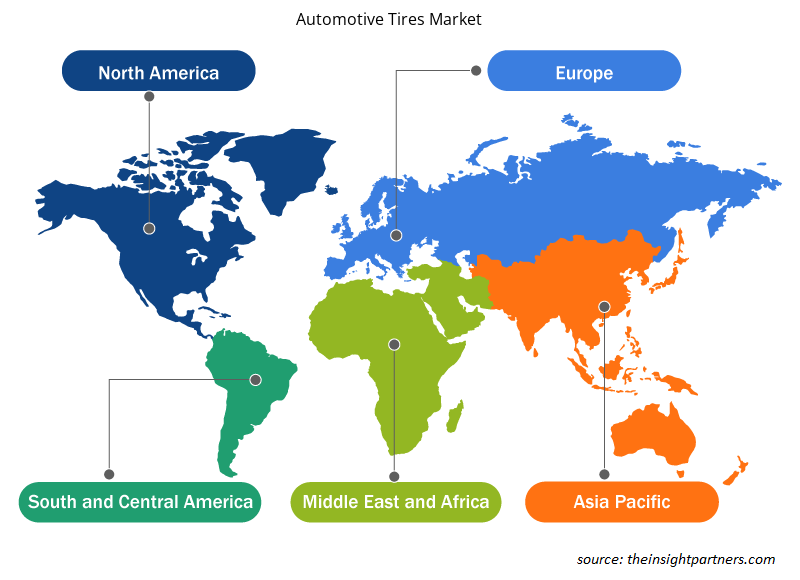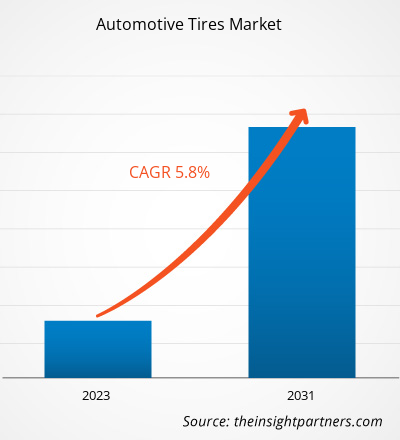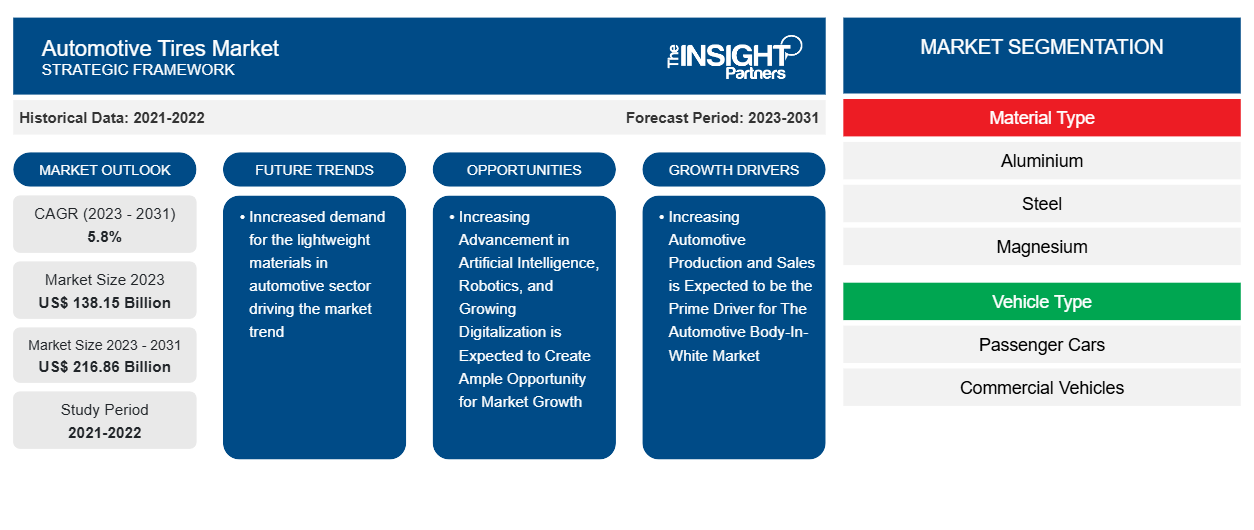Si prevede che il mercato degli pneumatici per autoveicoli raggiungerà i 216,86 miliardi di dollari entro il 2031, rispetto ai 138,15 miliardi di dollari del 2023. Si prevede che il mercato registrerà un CAGR del 5,8% nel 2022-2031. L'aumento della produzione e delle vendite di automobili in tutto il mondo con rigide norme e regolamenti per materiali sostenibili per pneumatici guida la crescita del mercato. Secondo l'Automotive Industry Associations, il settore manifatturiero dell'industria automobilistica globale è stato valutato a circa 2,86 trilioni di dollari nel 2022 e si prevede che raggiungerà i 3,2 trilioni di dollari entro il 2026. Questa crescita è dovuta principalmente all'aumento delle vendite di nuovi veicoli tra i consumatori in tutto il mondo.
Analisi del mercato degli pneumatici per autoveicoli
Il mercato degli pneumatici per autoveicoli è guidato dall'aumento delle vendite e della produzione di autoveicoli insieme alla rapida crescita dei veicoli fuoristrada nei settori agricolo e minerario. I veicoli fuoristrada sono soggetti a condizioni di usura. Quindi, la domanda di pneumatici per autoveicoli è elevata in questi veicoli fuoristrada. Il settore delle costruzioni in rapida crescita, insieme alla crescente domanda da parte delle nazioni in via di sviluppo in tutto il mondo, è il principale fattore trainante per la crescita del mercato. Gli pneumatici per autoveicoli devono essere cambiati dopo un certo periodo. Inoltre, l'aumento delle vendite di automobili e la crescita delle vendite di veicoli commerciali tra i consumatori hanno creato un'enorme domanda di crescita del mercato degli pneumatici per autoveicoli. Le vendite di autovetture hanno la quota maggiore nel mercato complessivo. Le vendite di veicoli a motore in tutto il mondo sono aumentate del 5% dal 2020 al 2021. Si prevede che tale crescita delle vendite di automobili in tutto il mondo creerà ampie opportunità per la crescita del mercato durante il periodo di previsione.
Personalizza questo report in base alle tue esigenze
Riceverai la personalizzazione gratuita di qualsiasi report, comprese parti di questo report, o analisi a livello nazionale, pacchetto dati Excel, oltre a usufruire di grandi offerte e sconti per start-up e università
- Scopri le principali tendenze di mercato in questo rapporto.Questo campione GRATUITO includerà analisi di dati che spaziano dalle tendenze di mercato alle stime e alle previsioni.
Driver e opportunità del mercato degli pneumatici per autoveicoli
La crescita delle vendite di veicoli commerciali e autovetture sta spingendo la crescita del mercato
L'aumento delle vendite e della produzione di automobili nei paesi in via di sviluppo, tra cui Cina, India, Messico, Brasile e Giappone, sta guidando il mercato degli pneumatici per autoveicoli durante il periodo di previsione. Secondo la China Association of Automobile Manufacturers Organization, a marzo 2023, le vendite di autovetture sono aumentate a oltre 1,05 milioni di unità, con un aumento del 20,4% rispetto al mese precedente, 2023. Inoltre, l'aumento delle vendite globali di automobili in tutto il mondo sta guidando la crescita del mercato globale degli pneumatici per autoveicoli. Secondo l'Agenzia internazionale per l'energia, nel 2023, la produzione automobilistica globale ha raggiunto 93,0 milioni di unità, con un aumento dell'11,2% rispetto al 2022. Tale crescita nella produzione e nelle vendite di automobili ha creato un'enorme domanda per la crescita del mercato durante il periodo di previsione.
Si prevede che il crescente sviluppo del sistema intelligente per il monitoraggio della pressione dei pneumatici creerà ampie opportunità di crescita per il mercato degli pneumatici per autoveicoli durante il periodo di previsione.
I progressi nella produzione di pneumatici per autoveicoli, come l'integrazione di pneumatici intelligenti con sensori integrati per ridurre i costi di guida complessivi, guidano le opportunità di mercato. Diversi attori chiave del mercato, come Continental AG e Hankook, stanno investendo in queste tecnologie avanzate per offrire una guida sicura e migliorare l'efficienza del veicolo. Gli pneumatici intelligenti monitorano letture accurate di pressione e temperatura dai sensori nel rivestimento interno dello pneumatico. Ad esempio, a febbraio 2023, Continental AG ha lanciato Conti Connect Tire con assistenza in tempo reale alle flotte basata su soluzioni basate su cloud in tempo reale. È costruito con un sistema di monitoraggio digitale intelligente degli pneumatici per i veicoli della flotta. Gli pneumatici Continental sono costituiti da sensori per raccogliere dati all'interno degli pneumatici.Hankook, are investing in these advanced technologies to offer safe driving and enhance vehicle efficiency. Intelligent tires monitor accurate Conti Connect Tire with Live cloud-based solution assistance in the fleets in real-time. It is built with an intelligent digital tire monitoring system for the vehicles in the fleet. Continental tires consist of sensors to collect data inside the tires.
Analisi della segmentazione del rapporto di mercato degli pneumatici per autoveicoli
I segmenti chiave che hanno contribuito alla derivazione dell'analisi del mercato degli pneumatici per autoveicoli sono il tipo di veicolo, la dimensione del cerchio, il design e il tipo di pneumatico.
- In base al tipo di veicolo, il mercato è suddiviso in autovetture, veicoli commerciali leggeri e veicoli commerciali pesanti. Tra questi, le autovetture hanno la quota maggiore nel 2023.
- In base alla dimensione del cerchio, il mercato è diviso in 13''-15'', 16''-18'', 19''-21'', oltre 21"
- In base al design, il mercato è diviso in radiale e bias. Tra questi, il design radiale ha la quota maggiore nel 2023 durante il periodo di previsione.
- In base al tipo di pneumatico, il mercato si divide in tubeless e con camera d'aria.
Analisi della quota di mercato degli pneumatici per autoveicoli per area geografica
L'ambito geografico del rapporto sul mercato degli pneumatici per autoveicoli è suddiviso principalmente in cinque regioni: Nord America, Europa, Asia Pacifico, Medio Oriente e Africa e Sud America.
Si prevede che l'Asia Pacifica dominerà il mercato durante il periodo di previsione a causa dell'aumento delle vendite di veicoli in questa regione. I paesi leader come India, Giappone e Cina, guidano la crescita del mercato degli pneumatici per autoveicoli durante il periodo di previsione. Ciò è dovuto principalmente all'aumento della domanda da parte dell'enorme base di popolazione in Cina e India, i principali fattori trainanti per la crescita del mercato degli pneumatici per autoveicoli in India e Cina.
Anche l'Europa sta crescendo a un ritmo rapido nel mercato degli pneumatici per autoveicoli, grazie all'aumento delle vendite di questo tipo di prodotti e all'aumento del reddito disponibile delle persone in questa regione.
Approfondimenti regionali sul mercato degli pneumatici per autoveicoli
Le tendenze regionali e i fattori che influenzano il mercato degli pneumatici per autoveicoli durante il periodo di previsione sono stati ampiamente spiegati dagli analisti di Insight Partners. Questa sezione discute anche i segmenti e la geografia del mercato degli pneumatici per autoveicoli in Nord America, Europa, Asia Pacifico, Medio Oriente e Africa e America meridionale e centrale.

- Ottieni i dati specifici regionali per il mercato degli pneumatici per autoveicoli
Ambito del rapporto sul mercato degli pneumatici per autoveicoli
| Attributo del report | Dettagli |
|---|---|
| Dimensioni del mercato nel 2023 | 138,15 miliardi di dollari USA |
| Dimensioni del mercato entro il 2031 | 216,86 miliardi di dollari USA |
| CAGR globale (2023-2031) | 5,8% |
| Dati storici | 2021-2022 |
| Periodo di previsione | 2023-2031 |
| Segmenti coperti | Per tipo di materiale
|
| Regioni e Paesi coperti | America del Nord
|
| Leader di mercato e profili aziendali chiave |
|
Densità degli attori del mercato: comprendere il suo impatto sulle dinamiche aziendali
Il mercato degli pneumatici per autoveicoli sta crescendo rapidamente, spinto dalla crescente domanda degli utenti finali dovuta a fattori quali l'evoluzione delle preferenze dei consumatori, i progressi tecnologici e una maggiore consapevolezza dei vantaggi del prodotto. Con l'aumento della domanda, le aziende stanno ampliando le loro offerte, innovando per soddisfare le esigenze dei consumatori e capitalizzando sulle tendenze emergenti, il che alimenta ulteriormente la crescita del mercato.
La densità degli operatori di mercato si riferisce alla distribuzione di aziende o società che operano in un particolare mercato o settore. Indica quanti concorrenti (operatori di mercato) sono presenti in un dato spazio di mercato in relazione alle sue dimensioni o al valore di mercato totale.
Le principali aziende che operano nel mercato degli pneumatici per autoveicoli sono:
- ABB Ltd.
- Benteler International AG
- CIE Automobilistico
- Sistemi automobilistici Dura
- Gestamp Automocion SA
- Azienda Kuka
Disclaimer : le aziende elencate sopra non sono classificate secondo un ordine particolare.

- Ottieni una panoramica dei principali attori del mercato degli pneumatici per autoveicoli
Notizie e sviluppi recenti sul mercato degli pneumatici per autoveicoli
Il mercato viene valutato raccogliendo dati qualitativi e quantitativi dopo la ricerca primaria e secondaria, che include importanti pubblicazioni aziendali, dati associativi e database. Di seguito è riportato un elenco degli sviluppi nel mercato per il mercato e le strategie degli pneumatici per autoveicoli:
- A gennaio 2023, Sumitomo Rubber Industries ha stretto una partnership con Global Data Service per l'espansione del business dei pneumatici e dei componenti per autoveicoli. Il produttore di pneumatici per autoveicoli ha progettato per consentire agli utenti di accedere ai dati utilizzando i pneumatici con l'ausilio della tecnologia RFID. (Fonte: DJI, comunicato stampa/sito Web aziendale/newsletter)
- Nell'ottobre 2022, Hankook Tire ha introdotto il pneumatico AU06+ Smart iON Radial per camion e autobus per veicoli elettrici premium. (Fonte: DJI, comunicato stampa/sito Web aziendale/newsletter)
Copertura e risultati del rapporto sul mercato degli pneumatici per autoveicoli
Il rapporto "Dimensioni e previsioni del mercato degli pneumatici per autoveicoli (2021-2031)" fornisce un'analisi dettagliata del mercato che copre le seguenti aree:
- Dimensioni e previsioni del mercato a livello globale, regionale e nazionale per tutti i segmenti di mercato chiave coperti dall'ambito
- Dinamiche di mercato come fattori trainanti, vincoli e opportunità chiave
- Principali tendenze future
- Analisi dettagliata delle cinque forze di Porter
- Analisi di mercato globale e regionale che copre le principali tendenze di mercato, i principali attori, le normative e gli sviluppi recenti del mercato
- Analisi del panorama industriale e della concorrenza che copre la concentrazione del mercato, l'analisi della mappa di calore, i principali attori e gli sviluppi recenti
- Profili aziendali dettagliati con analisi SWOT
- Analisi storica (2 anni), anno base, previsione (7 anni) con CAGR
- Analisi PEST e SWOT
- Valore/volume delle dimensioni del mercato - Globale, Regionale, Nazionale
- Industria e panorama competitivo
- Set di dati Excel
Report recenti
Testimonianze
Motivo dell'acquisto
- Processo decisionale informato
- Comprensione delle dinamiche di mercato
- Analisi competitiva
- Analisi dei clienti
- Previsioni di mercato
- Mitigazione del rischio
- Pianificazione strategica
- Giustificazione degli investimenti
- Identificazione dei mercati emergenti
- Miglioramento delle strategie di marketing
- Aumento dell'efficienza operativa
- Allineamento alle tendenze normative





















 Ottieni un campione gratuito per - Mercato degli pneumatici per autoveicoli
Ottieni un campione gratuito per - Mercato degli pneumatici per autoveicoli